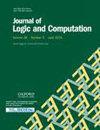道义逻辑中的允许规范和规范规范
IF 0.7
4区 数学
Q3 COMPUTER SCIENCE, THEORY & METHODS
引用次数: 0
摘要
本文系统地分析了输入/输出(I/O)逻辑中众所周知的弱权限和强权限概念。我们将Makinson和Van der Torre最初提出的权限解释扩展到过去二十年中开发的整个I/O系统家族。主要贡献是基于建立所谓的不重复性质的一系列强许可表征结果。我们还研究了文献中尚未涉及的输入/输出逻辑。它支持案例推理——这是人类推理的自然特征。输出在逻辑蕴涵下不是封闭的。同时,它使用一致性检查(非单调逻辑中常见的一种技术)避免了多余的输出。这使得它非常适合于反职责推理。公理化表征是根据一个广义或规则。我们将讨论所有这些对我们理解规范系统的相干性概念的影响。确定了未来研究的主题本文章由计算机程序翻译,如有差异,请以英文原文为准。
Permissive and regulative norms in deontic logic
This article provides a systematic analysis of the well-known notions of weak and strong permission in input/output (I/O) logic. We extend the account of permission initially put forward by Makinson and Van der Torre to the whole family of I/O systems developed during the last two decades. The main contribution is a series of characterization results for strong permission, based on establishing the so-called non-repetition property. We also study an input/output logic not yet covered in the literature. It supports reasoning by cases—a natural feature of human reasoning. The output is not closed under logical entailment. At the same time, it avoids excess output using a consistency check—a technique familiar from non-monotonic logic. This makes it well suited for contrary-to-duty reasoning. The axiomatic characterization is in terms of a generalized OR rule. We discuss the implications of all this for our understanding of the notion of the coherence of a normative system. Topics for future research are identified.1
求助全文
通过发布文献求助,成功后即可免费获取论文全文。
去求助
来源期刊

Journal of Logic and Computation
工程技术-计算机:理论方法
CiteScore
1.90
自引率
14.30%
发文量
82
审稿时长
6-12 weeks
期刊介绍:
Logic has found application in virtually all aspects of Information Technology, from software engineering and hardware to programming and artificial intelligence. Indeed, logic, artificial intelligence and theoretical computing are influencing each other to the extent that a new interdisciplinary area of Logic and Computation is emerging.
The Journal of Logic and Computation aims to promote the growth of logic and computing, including, among others, the following areas of interest: Logical Systems, such as classical and non-classical logic, constructive logic, categorical logic, modal logic, type theory, feasible maths.... Logical issues in logic programming, knowledge-based systems and automated reasoning; logical issues in knowledge representation, such as non-monotonic reasoning and systems of knowledge and belief; logics and semantics of programming; specification and verification of programs and systems; applications of logic in hardware and VLSI, natural language, concurrent computation, planning, and databases. The bulk of the content is technical scientific papers, although letters, reviews, and discussions, as well as relevant conference reviews, are included.
 求助内容:
求助内容: 应助结果提醒方式:
应助结果提醒方式:


